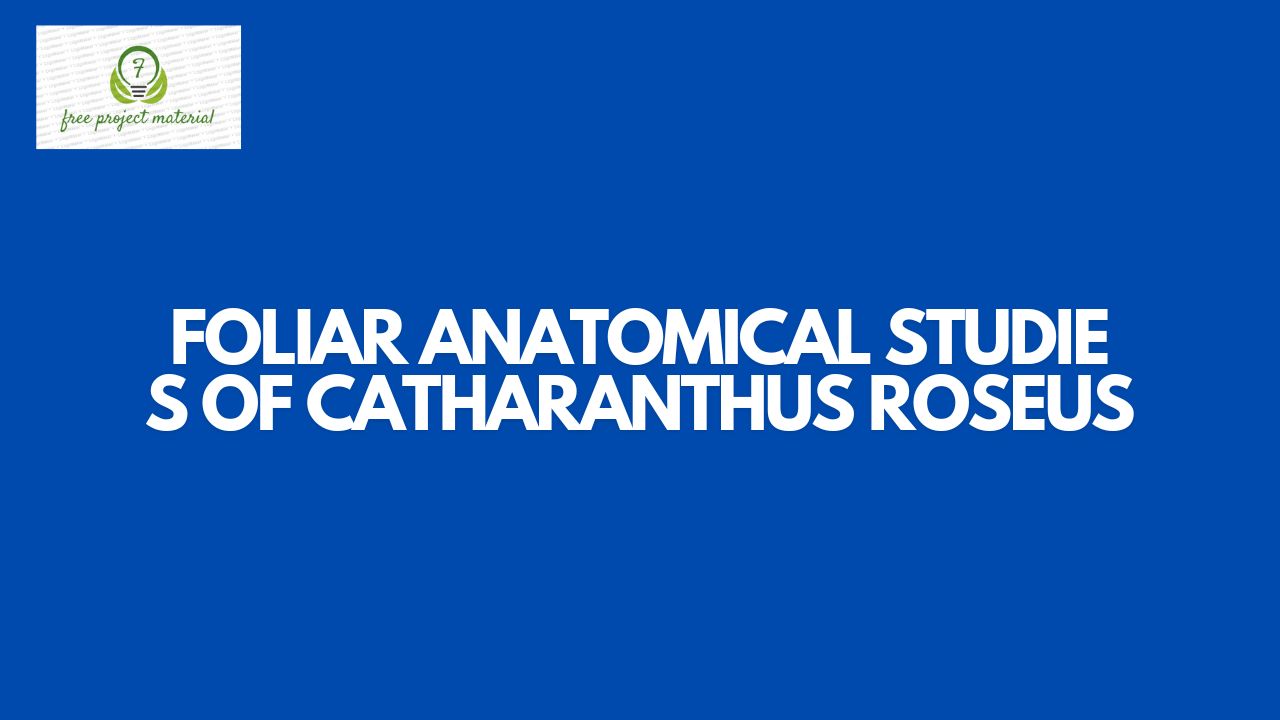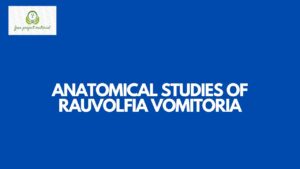ABSTRACT
The detailed morphological study of the leaf epidermis of the genus Catharantus in Uyo was studied. The study revealed several interesting epidermal features that have not previously been reported in the genus. Leaf epidermal characters such as pattern of epidermal cell. The epidermal cells were polygonal to irregular in shape with straight undulate anticlinal walls on the abaxial surface while polygonal to irregular anticlinal walls were observed on the adaxial surface. Leaves are amphistomatic respectively and are largely anomocytic on both surface. Also, trichomes stalked uniserrate were present on both surface. The type of stomata and shape of guard cell are constant on some species and variable in others and thus of great significance in understanding the relationship between and within species. It is therefore recommended that works should be carried out on phytochemical analysis of the stem bark of the Catharanthus roseus.
TABLE OF CONTENTS
Title page – – – – – – – – – i
Certification – – – – – – – – ii
Dedication – – – – – – – – – iii
Acknowledgements – – – – – – – iv
Abstract – – – – – – – – – v
Table of Contents – – – – – – – – vi
CHAPTER ONE: INTRODUCTION
1.1 Background of the study – – – – – – 1-2
1.2 Aim and Objective of the Study – – – – – 2
1.2.1 Aim of the study – – – – – – – 2
1.2.2 Objectives of the study – – – – – – 3
1.3 Scope and Limitation of the study – – – – – 3
CHAPTER TWO: LITERATURE REVIEW
2.1 Classification of Catharanthus roseus – – – 4
2.2 Ethno-botanical uses of catharathus roseus – – – 4-7
2.3 Botanical Description of Catharanthus roseus – – – 7-8
2.4 Traditional uses of Catharanthus roseus – – – – 8-14
2.5 Photochemistry – – – – – – – 14-15
2.5.1 Major Alkaloids – – – – – – – 15
2.6 Phytobioactivity – – – – – – – 16
2.6.1 Ethnobotanical importance – – – – – 16-17
2.6.2 Toxicity and side effect – – – – – – 18
2.6.3 Formulation and international Trade – – – 19-20
2.7 Pharmacological Activities – – – – – – 20
2.7.1 Antioxidant – – – – – – – – 20-21
2.7.2 Anti cancer property – – – – – – 21-22
2.7.3 Anti-Diabetic Activity – – – – – – 22
2.7.4 Anti microbial Activity – – – – – – 23
2.7.5 Anti-Ulcer property – – – – – – 23
2.7.6 Hypotension property – – – – – – 23
2.7.7 Anti-Diarrheal property – – – – – – 24
2.7.8 Wound Healing property – – – – – – 24
2.7.9 Hypolipidemic Effect – – – – – – 24
CHAPTER THREE: MATERIAL AND METHOD
3.1 Materials – – – – – – – – 25
3.2 Methods – – – – – – – – 26
3.2.1 Sample collection – – – – – – – 26
3.2.2 Anatomical studies – – – – – – – 26-27
CHAPTER FOUR: RESULTS AND DISCUSSION
4.1 Results – – – – – – – – – 28
4.2 Discussion – – – – – – – – 29-30
CHAPTER FIVE :CONCLUSION AND RECOMMENDATION
5.1 Conclusion – – – – – – – 31
5.2 Recommendation – – – – – – – 31
References
CHAPTER ONE: INTRODUCTION
1.1 Background of The Study
Plant serves as vast source for varied phytoconstituents exhibiting varied pharmacological property (Shylaja et al., 2018). Identifying such potential plants is of significance in medicine, so it becomes necessary to study the pharmacognostic characteristic of the plants before its use in the field or research and also in pharmaceutical formulation. Moreover it also helps in distinction from other allied species and adulterants. Morphological and anatomical characters of leaf are used as taxonomic markers to assist in the correct identification of the plant species; (Mustafa et al., 2013). The foliar epidermis is one of the most note-worthy taxonomic characters from the biosystematics point of view and the taxonomic studies of number of families are made on the basis of leaf epidermis (Hisiger and Jolicoeur, 2007). Leaf epidermal anatomical features such as stomata, trichomes and other characters are useful anatomical tools. According WHO, the morphological (macroscopic) descriptions of a medicinal plant is first step towards establishing its identity and should be carried out (Wang et al., 2011). Microscopic evaluation is an indispensable tool for identification of medicinal plants and is one of the essential parameters in modern monograph.
The leaves of Catharanthus roseus are oval to oblong 2.5cm-9cm long and 1-3.5cm broad, glossy green, hairless with a pale midrib and a short petiole about 1-1.8cm long and they are arranged in opposite pairs (Vega-Avida et al., 2012). In India, the juice of leaves is used as application to bee-sting, wasp-strip. In Africa, the leaves of Catharanthus roseus are used for hemorrhage and rheumatism (Vega-Avida et al., 2012).
1.2 Aim and objective of the study
1.2.1 Aim of the Study
The aim of this study is to determine epidermal characters of Catharanthus roseus
1.2.2 Objective of the Study
The Objectives of this Study is;
- To assess epidermal characters of Catharanthus roseus
- To analyze the values obtained using statistical tools
1.3 Scope and Limitation of the Study
The scope of this work focus on foliar-anatomical studies of Catharanthus roseus due to Delta variance.



